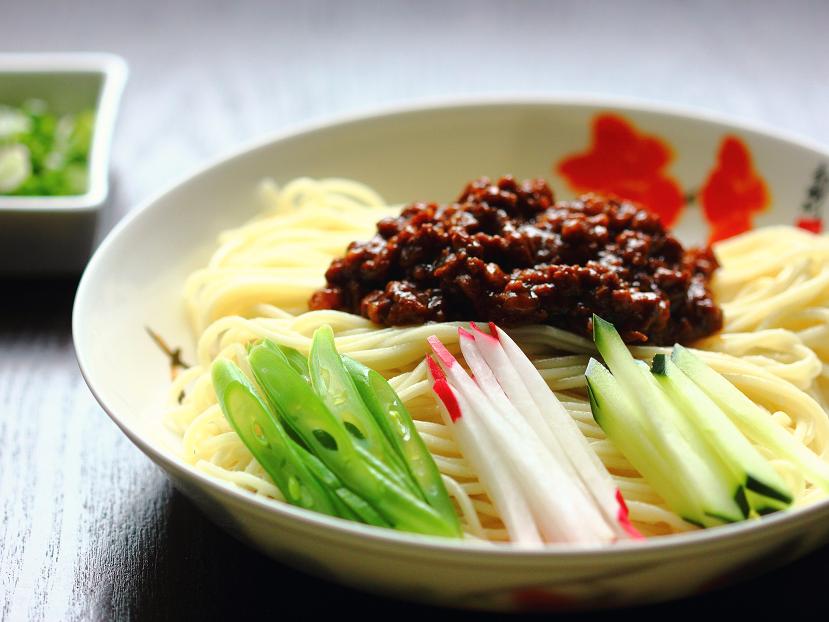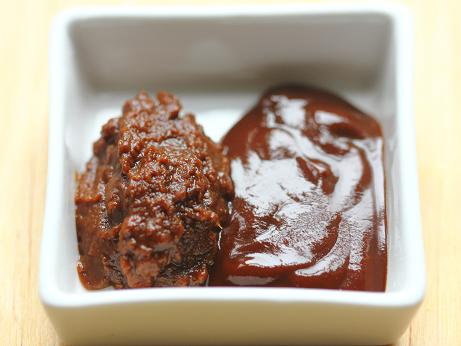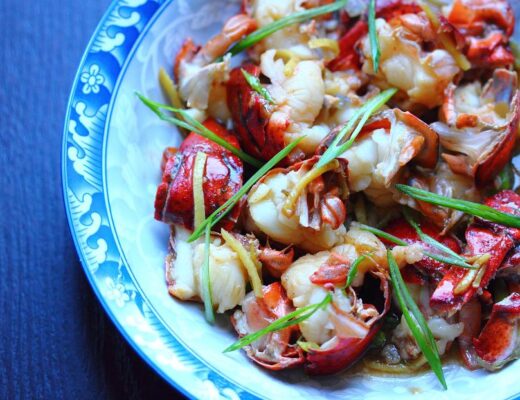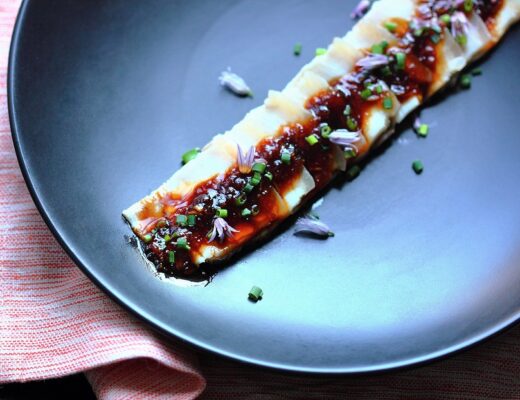Last Updated on May 18, 2021 by Simon Fan
The food of Beijing is a delicious mix of highbrow and lowbrow, ranging from spectacular imperial dishes, such as the world-renowned Peking duck, to comforting home-style dishes, especially handmade noodles, dumplings, and buns that are eaten every day by all walks of life.
One of the dishes many Beijing locals swear by is zha jiang noodles (炸酱面). What sets it apart from other noodle dishes is the sauce, zha jiang, meaning “fried sauce”.
In the old Beijing style, zha jiang is made with fatty pork and two fermented pastes used frequently in Northern cooking: huang jiang (黄酱, yellow soybean paste), the one on the left in the picture; and tian mian jiang (甜面酱, sweet flour sauce), on the right. Together they create an intensely aromatic sauce that’s salty, sweet, and loaded with umami flavor.
Beijingers love to add a large variety of seasonal vegetables to their zha jiang noodles, creating a balanced and nutritious one-dish meal. The best options are those vegetables with a crunchy texture and natural sweetness, and can be served raw or after blanched briefly, such as cucumbers, radishes, green beans, peas, and bean sprouts.
The beauty of this dish is that it’s versatile and adaptable, which explains why it has spread all over China, and into Korea and Japan. It can be served cold or hot with seasonal vegetables available in the market. You can replace the pork with chicken, lamb, beef, or substitute mushrooms or tofu for a vegetarian version. If you cannot find huang jiang, substitute another soybean paste. You can also use hoisin sauce instead of tian mian jiang,
When you make a sauce such as zha jiang or ragù Bolognese that benefits from long cooking to develop rich flavors, it’s a good idea to make a large quantity. My recipe below makes enough sauce for at least 4 to 6 servings.
Zha jiang noodles, old Beijing style (老北京炸酱面)
Serves 2
Ingredients
Sauce (enough for at least 4 to 6 servings; scale up or down as needed)
4 oz (115 g) huang jiang (yellow soybean paste) or another soybean paste
2 oz (60 g) tian mian jiang (sweet flour sauce) or hoisin sauce
1 tablespoon vegetable oil
1 lb (450 g) pork belly, finely chopped, or ground pork
1-inch (2.5 cm) piece of ginger, peeled and grated
1 tablespoon Shaoxing wine
1 teaspoon sugar
1 cup (240 ml) water
8 oz (230 g) fresh noodles, or 6 oz (170 g) dried noodles
Toppings
2 oz (60 g) radish, cut into ⅛-inch-thick (3 mm) matchsticks and soaked in ice or cold water for extra crispness
2 oz (60 g) cucumber, cut into ⅛-inch-thick (3 mm) matchsticks and soaked in ice or cold water for extra crispness
2 oz (60 g) green beans, blanched and sliced diagonally
Additional seasonings or garnishes of your choice, such as Zhenjiang (aka Chinkiang) vinegar, chili oil, minced garlic, or sliced scallions.
Directions
- In a bowl, combine the huang jiang and tian mian jiang.
- Place a wok or skillet over medium-low heat until hot, then swirl in the oil. When the oil starts to shimmer, add the pork and stir-fry until it has rendered most of the fat, 4 to 5 minutes.
- Transfer the pork to a bowl, leaving the rendered fat in the wok. Add the mixed paste and stir-fry over medium-low heat until fragrant, about 1 minute. Return the pork to the wok, and add the ginger, wine, and sugar. Stir and mix for 30 seconds. Pour in the water and stir to mix. Bring to a boil, then reduce to a gentle simmer. Cover and cook until the meat sauce is fully flavored, about 30 minutes. The sauce should taste slightly salty to flavor the noodles, so adjust the seasoning as needed.
- While the sauce is simmering, cook the noodles in boiling water as per package instructions. When they’re just cooked through, transfer them to a colander to drain well. If you plan to serve the noodles cold, rinse under cold water and drain well.
- Divide the noodles between two large bowls. Top them with the sauce, vegetables, and any additional seasonings or garnishes of your choice. Mix well and enjoy!





Zha Jiang Noodles – Site Title
March 1, 2017 at 5:20 PM[…] Recipe […]
Tofu rolls with soybean sauce | Soy, Rice, Fire
August 31, 2020 at 2:56 PM[…] Note: Huang jiang (黄酱, yellow soybean paste) is one of the traditional Chinese fermented pastes made from soybeans. Other ingredients include salt, water, wheat flour, and sometimes sugar. The “yellow” in the name refers to the fact that it’s made from yellow soybeans. The color of the paste is actually dark brown as you can see from the picture. With a rich and complex flavor resulted from fermentation, huang jiang is an important seasoning in Chinese cuisine, especially in the cooking of northern China. One of the most famous dishes featuring yellow soybean paste is zha jiang noodles (炸酱面). […]